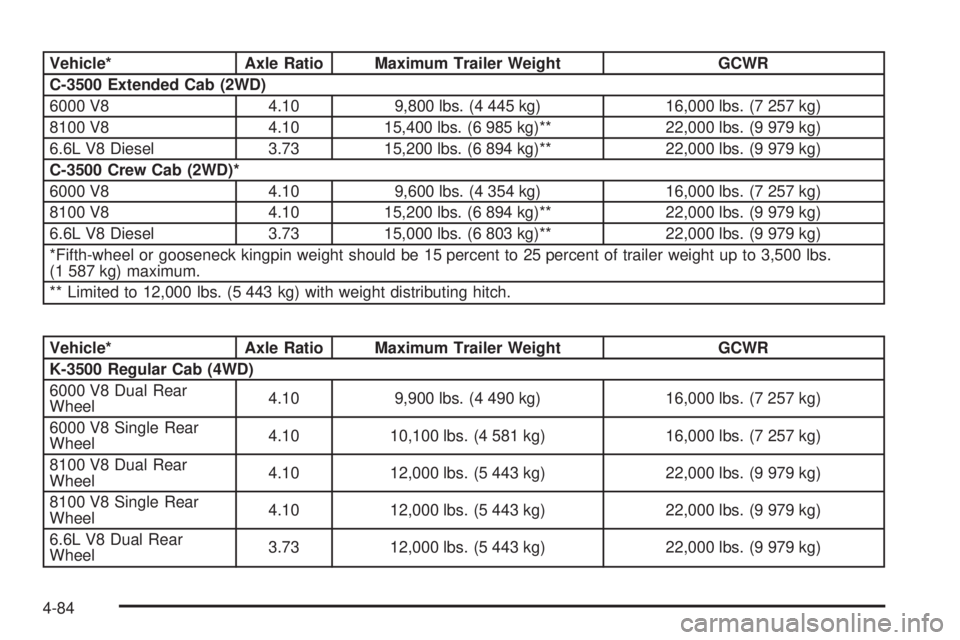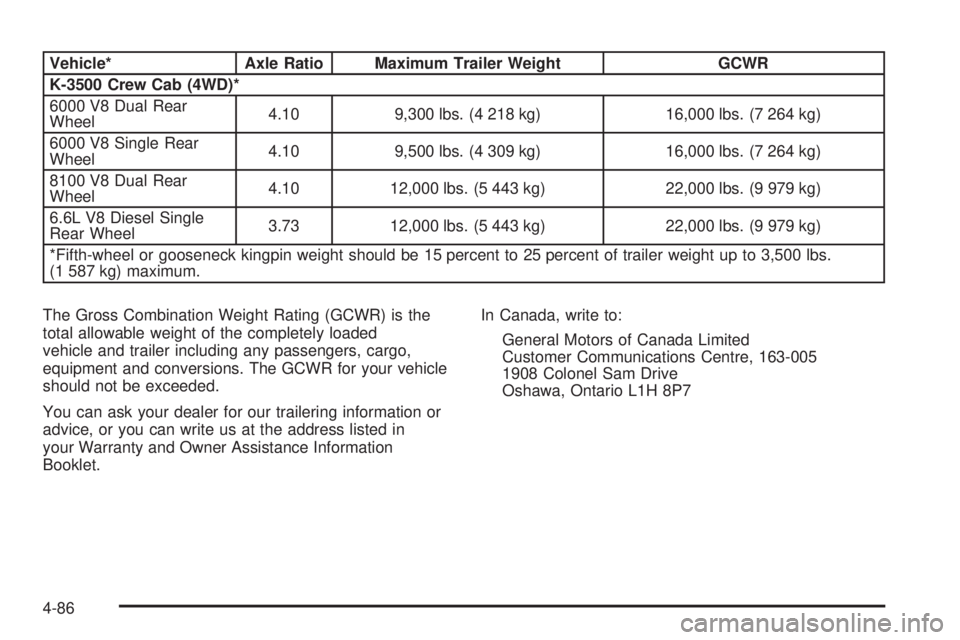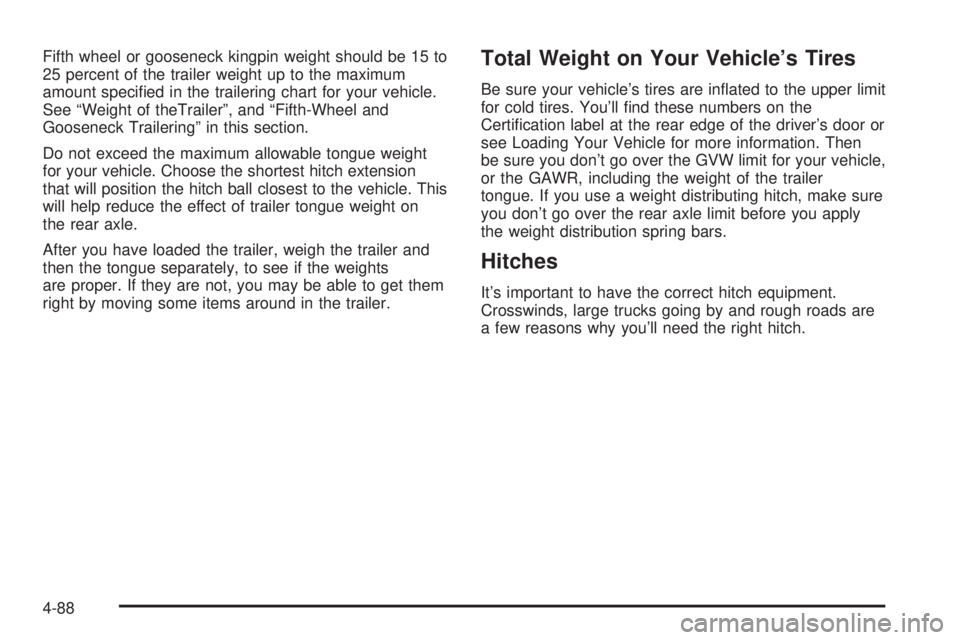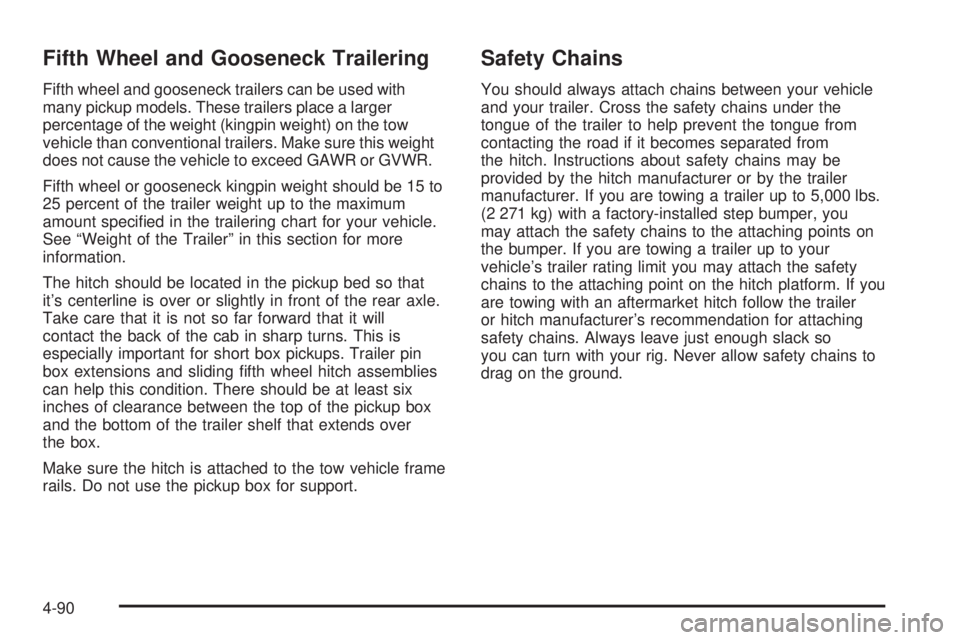Page 380 of 588

Vehicle* Axle Ratio Maximum Trailer Weight GCWR
C-3500 Extended Cab (2WD)
6000 V8 4.10 9,800 lbs. (4 445 kg) 16,000 lbs. (7 257 kg)
8100 V8 4.10 15,400 lbs. (6 985 kg)** 22,000 lbs. (9 979 kg)
6.6L V8 Diesel 3.73 15,200 lbs. (6 894 kg)** 22,000 lbs. (9 979 kg)
C-3500 Crew Cab (2WD)*
6000 V8 4.10 9,600 lbs. (4 354 kg) 16,000 lbs. (7 257 kg)
8100 V8 4.10 15,200 lbs. (6 894 kg)** 22,000 lbs. (9 979 kg)
6.6L V8 Diesel 3.73 15,000 lbs. (6 803 kg)** 22,000 lbs. (9 979 kg)
*Fifth-wheel or gooseneck kingpin weight should be 15 percent to 25 percent of trailer weight up to 3,500 lbs.
(1 587 kg) maximum.
** Limited to 12,000 lbs. (5 443 kg) with weight distributing hitch.
Vehicle* Axle Ratio Maximum Trailer Weight GCWR
K-3500 Regular Cab (4WD)
6000 V8 Dual Rear
Wheel4.10 9,900 lbs. (4 490 kg) 16,000 lbs. (7 257 kg)
6000 V8 Single Rear
Wheel4.10 10,100 lbs. (4 581 kg) 16,000 lbs. (7 257 kg)
8100 V8 Dual Rear
Wheel4.10 12,000 lbs. (5 443 kg) 22,000 lbs. (9 979 kg)
8100 V8 Single Rear
Wheel4.10 12,000 lbs. (5 443 kg) 22,000 lbs. (9 979 kg)
6.6L V8 Dual Rear
Wheel3.73 12,000 lbs. (5 443 kg) 22,000 lbs. (9 979 kg)
4-84
Page 381 of 588
Vehicle* Axle Ratio Maximum Trailer Weight GCWR
6.6L V8 Single Rear
Wheel3.73 12,000 lbs. (5 443 kg) 22,000 lbs. (9 979 kg)
K-3500 Extended Cab (4WD)*
6000 V8 Dual Rear
Wheel4.10 9,500 lbs. (4 309 kg) 16,000 lbs. (7 257 kg)
6000 V8 Single Rear
Wheel4.10 9,700 lbs. (4 399 kg) 16,000 lbs. (7 257 kg)
8100 V8 Dual Rear
Wheel4.10 12,000 lbs. (5 443 kg) 22,000 lbs. (9 979 kg)
8100 V8 Single Rear
Wheel4.10 12,000 lbs. (5 443 kg) 22,000 lbs. (9 979 kg)
6.6L V8 Diesel Dual
Rear Wheel3.73 12,000 lbs. (5 443 kg) 22,000 lbs. (9 979 kg)
6.6L V8 Diesel Single
Rear Wheel3.73 12,000 lbs. (5 443 kg) 22,000 lbs. (9 979 kg)
* Fifth-wheel or gooseneck kingpin weight should be 15 percent to 25 percent of trailer weight up to 3,500 lbs.
(1 587 kg) maximum.
4-85
Page 382 of 588

Vehicle* Axle Ratio Maximum Trailer Weight GCWR
K-3500 Crew Cab (4WD)*
6000 V8 Dual Rear
Wheel4.10 9,300 lbs. (4 218 kg) 16,000 lbs. (7 264 kg)
6000 V8 Single Rear
Wheel4.10 9,500 lbs. (4 309 kg) 16,000 lbs. (7 264 kg)
8100 V8 Dual Rear
Wheel4.10 12,000 lbs. (5 443 kg) 22,000 lbs. (9 979 kg)
6.6L V8 Diesel Single
Rear Wheel3.73 12,000 lbs. (5 443 kg) 22,000 lbs. (9 979 kg)
*Fifth-wheel or gooseneck kingpin weight should be 15 percent to 25 percent of trailer weight up to 3,500 lbs.
(1 587 kg) maximum.
The Gross Combination Weight Rating (GCWR) is the
total allowable weight of the completely loaded
vehicle and trailer including any passengers, cargo,
equipment and conversions. The GCWR for your vehicle
should not be exceeded.
You can ask your dealer for our trailering information or
advice, or you can write us at the address listed in
your Warranty and Owner Assistance Information
Booklet.In Canada, write to:
General Motors of Canada Limited
Customer Communications Centre, 163-005
1908 Colonel Sam Drive
Oshawa, Ontario L1H 8P7
4-86
Page 384 of 588

Fifth wheel or gooseneck kingpin weight should be 15 to
25 percent of the trailer weight up to the maximum
amount speci®ed in the trailering chart for your vehicle.
See ªWeight of theTrailerº, and ªFifth-Wheel and
Gooseneck Traileringº in this section.
Do not exceed the maximum allowable tongue weight
for your vehicle. Choose the shortest hitch extension
that will position the hitch ball closest to the vehicle. This
will help reduce the effect of trailer tongue weight on
the rear axle.
After you have loaded the trailer, weigh the trailer and
then the tongue separately, to see if the weights
are proper. If they are not, you may be able to get them
right by moving some items around in the trailer.Total Weight on Your Vehicle's Tires
Be sure your vehicle's tires are in¯ated to the upper limit
for cold tires. You'll ®nd these numbers on the
Certi®cation label at the rear edge of the driver's door or
see Loading Your Vehicle for more information. Then
be sure you don't go over the GVW limit for your vehicle,
or the GAWR, including the weight of the trailer
tongue. If you use a weight distributing hitch, make sure
you don't go over the rear axle limit before you apply
the weight distribution spring bars.
Hitches
It's important to have the correct hitch equipment.
Crosswinds, large trucks going by and rough roads are
a few reasons why you'll need the right hitch.
4-88
Page 386 of 588

Fifth Wheel and Gooseneck Trailering
Fifth wheel and gooseneck trailers can be used with
many pickup models. These trailers place a larger
percentage of the weight (kingpin weight) on the tow
vehicle than conventional trailers. Make sure this weight
does not cause the vehicle to exceed GAWR or GVWR.
Fifth wheel or gooseneck kingpin weight should be 15 to
25 percent of the trailer weight up to the maximum
amount speci®ed in the trailering chart for your vehicle.
See ªWeight of the Trailerº in this section for more
information.
The hitch should be located in the pickup bed so that
it's centerline is over or slightly in front of the rear axle.
Take care that it is not so far forward that it will
contact the back of the cab in sharp turns. This is
especially important for short box pickups. Trailer pin
box extensions and sliding ®fth wheel hitch assemblies
can help this condition. There should be at least six
inches of clearance between the top of the pickup box
and the bottom of the trailer shelf that extends over
the box.
Make sure the hitch is attached to the tow vehicle frame
rails. Do not use the pickup box for support.
Safety Chains
You should always attach chains between your vehicle
and your trailer. Cross the safety chains under the
tongue of the trailer to help prevent the tongue from
contacting the road if it becomes separated from
the hitch. Instructions about safety chains may be
provided by the hitch manufacturer or by the trailer
manufacturer. If you are towing a trailer up to 5,000 lbs.
(2 271 kg) with a factory-installed step bumper, you
may attach the safety chains to the attaching points on
the bumper. If you are towing a trailer up to your
vehicle's trailer rating limit you may attach the safety
chains to the attaching point on the hitch platform. If you
are towing with an aftermarket hitch follow the trailer
or hitch manufacturer's recommendation for attaching
safety chains. Always leave just enough slack so
you can turn with your rig. Never allow safety chains to
drag on the ground.
4-90
Page 387 of 588

Trailer Brakes
If your trailer weighs more than 2,000 lbs. (900 kg)
loaded, then it needs its own brakes ± and they must be
adequate. Be sure to read and follow the instructions
for the trailer brakes so you'll be able to install,
adjust and maintain them properly.
Your trailer brake system can tap into the vehicle's
hydraulic brake system only if:
·The trailer parts can withstand 3,000 psi
(20 650 kPa) of pressure.
·The trailer's brake system will use less than
0.02 cubic inch (0.3 cc) of ¯uid from your vehicle's
master cylinder. Otherwise, both braking systems
won't work well. You could even lose your brakes.
If everything checks out this far, make the brake tap at
the port on the master cylinder that sends the ¯uid
to the rear brakes. But don't use copper tubing for this.
If you do, it will bend and ®nally break off. Use steel
brake tubing.
Driving with a Trailer
{CAUTION:
If you have a rear-most window open and you
pull a trailer with your vehicle, carbon
monoxide (CO) could come into your vehicle.
You can not see or smell CO. It can cause
unconsciousness or death. See
Engine
Exhaust on page 2-53
. To maximize your safety
when towing a trailer:
·Have your exhaust system inspected for
leaks, and make necessary repairs before
starting on your trip.
·Keep the rear-most windows closed.
·If exhaust does come into your vehicle
through a window in the rear or another
opening, drive with your front, main
heating or cooling system on and with the
fan on any speed. This will bring fresh,
outside air into your vehicle. Do not use
the climate control setting for maximum air
because it only recirculates the air inside
your vehicle. See
Climate Control System
on page 3-21.
4-91
Page 391 of 588

When You Are Ready to Leave After
Parking on a Hill
1. Apply your regular brakes and hold the pedal down
while you:
·Start your engine
·Shift into a gear
·Release the parking brake
2. Let up on the brake pedal.
3. Drive slowly until the trailer is clear of the chocks.
4. Stop and have someone pick up and store the
chocks.
Maintenance When Trailer Towing
Your vehicle will need service more often when you're
pulling a trailer. SeeScheduled Maintenance on
page 6-4for more information. Things that are especially
important in trailer operation are automatic transmission
¯uid (don't over®ll), engine oil, axle lubricant, belt,
cooling system and brake system. Each of these is
covered in this manual, and the Index will help you ®nd
them quickly. If you're trailering, it's a good idea to
review these sections before you start your trip.
Check periodically to see that all hitch nuts and bolts
are tight.
Trailer Wiring Harness
Your vehicle is equipped with one of the following wiring
harnesses for towing a trailer or hauling a slide-in
camper.
Basic Trailer Wiring
All regular, extended cab crew cab pickups have a
six-wire trailer towing harness.
The six-wire harness is located at the rear of the vehicle
and is tied to the vehicle's frame. The harness requires
the installation of a trailer-wiring harness connector,
which is available through your dealer.
4-95
Page 394 of 588
If your vehicle is equipped with the ªHeavy-Duty
Trailering²option, please refer toHeavy-Duty Trailer
Wiring Package, earlier in this section.
When the camper-wiring harness is ordered without the
heavy-duty trailering package, an eight-wire harness
with a seven-pin connector and separate CHMSL
connector are located at the rear of the vehicle and are
tied to the vehicle's frame.
Instrument Panel Jumper Wiring Harness
{CAUTION:
Be sure to use only the correct trailer brake
harness, the one intended for use on your
vehicle. If you use some other trailer brake
harness, even if it seems to ®t, your trailer
brakes may not work at all. You could have a
crash in which you or others could be injured.
Use only the trailer brake harness intended for
your vehicle. If it is no longer available to you,
be sure to get a proper replacement from your
dealer.
4-98